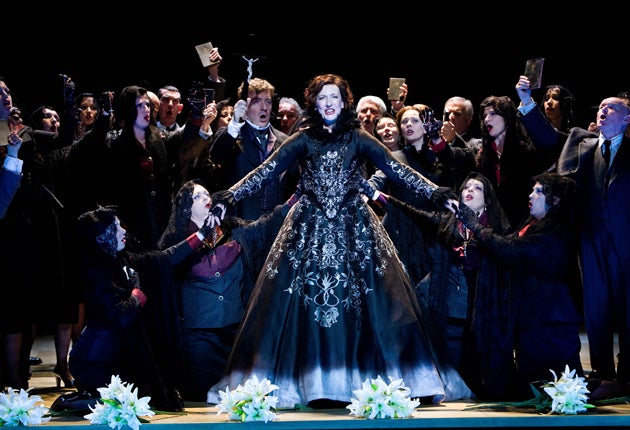Mary Stuart, Grand Theatre, Leeds<br/>Armida, Garsington, Oxford
Mary, Queen of Scots and Elizabeth I's costumes could have sprung from the sketchbooks of Balmain or Lacroi

Centuries merge and collide in Antony McDonald's haute couture production of Mary Stuart for Opera North.
Time and place were of little import to Donizetti – his Elizabeth and Essex romance, Roberto Devereux, opens with "God Save the Queen" (first published in 1745), while Emilia di Liverpool waxes gothic on the mountains of Merseyside – and the sombre pavanes of 16th-century England have no place in this pungent psychological drama, with its fictional encounter between Mary and Elizabeth, and its scandalous shriek of "vil bastarda!". Here, the warring queens' costumes could have sprung from the sketchbooks of Balmain or Lacroix, while their courtiers' suits reference the 1890s and 1960s. But Mary Stuart is less a history lesson than an exploration of iconhood.
McDonald's staging opens with two girls wearing paper crowns and nightdresses, alone in a chamber fashioned from sliding panels. As little Mary tears the crown from little Elizabeth's head, Elizabeth pulls the head off Mary's doll. Both girls are doomed: one to a life of neurotic virginity as the figurehead of a country battered by religious strife; the other to a series of brief marriages, political intrigues, a brutal death and an afterlife as the poster-girl for Catholic Europe. This is the heroine of Schiller's play, though Donizetti's 1830 adaptation balances Mary's suffering with a more vulnerable Elizabeth, hugging her knees to her chin in the opening scene of Act III, reluctant to sign the death warrant that would seal her solitude.
This is a taut, glamorous show with little wastage and some strong ensemble work in the Act II sextet. As the virgin queen, Antonia Cifrone's immaculate chignon, poker face and dry coloratura are contrasted with Sarah Connolly's loose curls, sensual movements and wistful horn- and harp-warmed cavatina "O nube, che lieve". There's an unfortunate tang of Margaret Lockwood's Wicked Lady as the women tussle over a riding crop, watched by a stricken Leicester (Bülent Bezduz) and a satisfied Cecil (David Kempster), whose physical familiarity with Elizabeth is one historical liberty too many. This aside, McDonald addresses the opera with due seriousness. Stepping in for Frédéric Bourreau, Trevor Bowes's Talbot supports Connolly tenderly in the Act III duet. Bezduz's Leicester is reliably persuasive and stylish. Still inhibited by a lingering throat infection, Connolly triumphs in the last scene, singing with grave intelligence and musicality. The bug must have spread to the chorus, who sound unusually strained. The Beethovenian pathos of the final prelude is confidently established by conductor Guido Johannes Rumstadt, the lighting (by Lucy Carter) thrilling at Connolly's exit.
Rolando Villazon's lively BBC4 documentary, What Makes a Great Tenor?, failed to mention one crucial quality: availability. Rossini's Armida calls for no fewer than six tenors, though in Martin Duncan's Garsington Opera production, the first in the UK, there are only four, with Bogdan Mihai and David Alegret doubling as Goffredo/ Carlo and Gernando/Ubaldo, and a faint whiff of bulk-discount casting. As Rinaldo, the diminutive Victor Ryan Robertson sounds like a passable Tamino unwisely pressed into later repertoire, while Nicholas Watts's Handelian Eustazio echoes the baroque accents in Rossini's orchestration.
Rossini could assume his audience's familiarity with Tasso's tale of supernatural seduction. At Garsington, bafflement was palpable as Jessica Pratt (Armida) repelled an army with a vague flick of her wrist, whisking the docile crusader, Rinaldo, off to her pleasure-resort. As user-unfriendly as Yannis Thavoris's set for Opera Holland Park's Pelléas and twice as ugly, Ashley Martin-Davis's two-tiered crusader encampment is reminiscent of Schiphol airport; and effortfully transformed into Armida's enchanted forest with luridly-lit tree trunks are a male chorus of dancing demons in Smurf-blue balaclavas and a bald female chorus with hermaphrodite genitalia stitched on to their camiknickers. There's no attempt to reproduce the dragon-drawn chariot in which Armida exits, cursing her one-knight stand.
What pleasure there is, is to be found in the score. The orchestration and chorus-writing is ravishing, with shades of Gluck's underworld, and cries out for the transparent textures of period instruments. The conductor, David Parry, nods in this direction with fleet tempi, but the woodwind were waterlogged on the opening night. Pratt's brilliant high E-flat, sinuous legato and well-drilled coloratura indicate a notable emerging talent, though Duncan's direction ensures that any characterisation begins and ends at Armida's cleavage. If paying up to £155 to sit in a tent and applaud Garsington's £250,000 tax rebate is your cup of tea, then go. If it isn't, listening to Renée Fleming's 1993 recording may make for a more comfortable evening.
'Mary Stuart': The Lowry, Salford Quays (0843-208 6010) 19 Jun, then touring. 'Armida': Garsington Opera (01865 361636) to 29 Jun
Next Week:
Anna Picard packs a fruit salad for The Love for Three Oranges, in David Fielding's production at Grange Park
Subscribe to Independent Premium to bookmark this article
Want to bookmark your favourite articles and stories to read or reference later? Start your Independent Premium subscription today.

Join our commenting forum
Join thought-provoking conversations, follow other Independent readers and see their replies